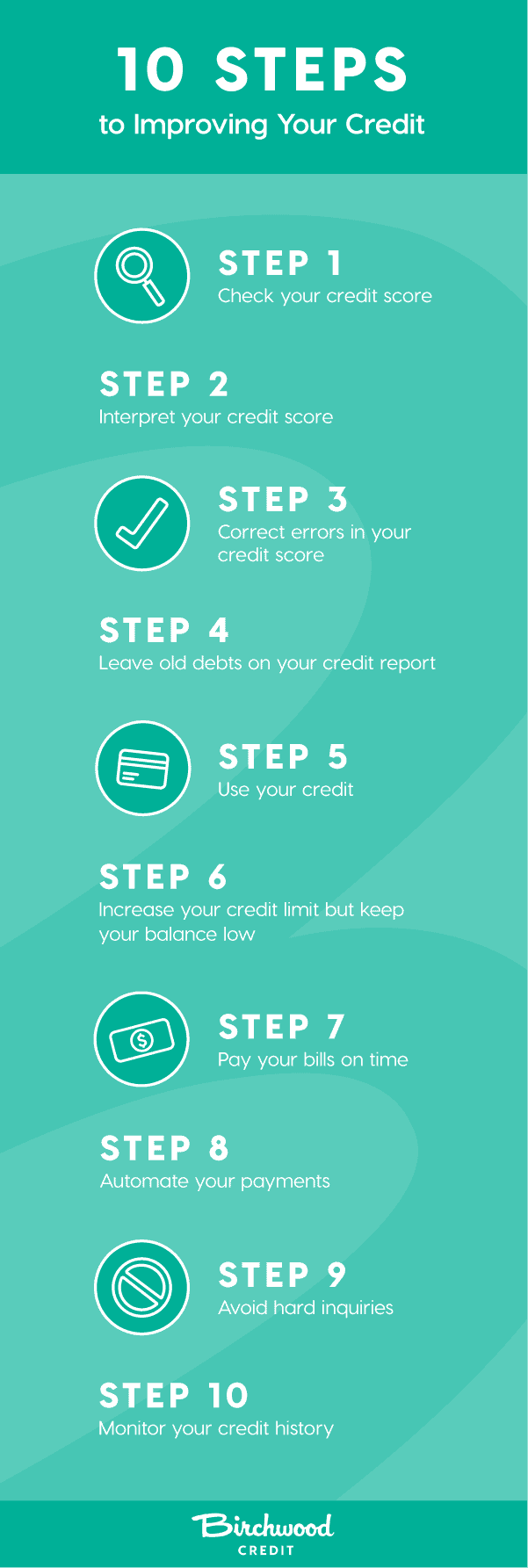
Learn How To Improve Your Credit Score in Canada With These 10 Steps
Everybody has a credit score and it speaks volumes about your financial health and management. Generally speaking, the better your credit, the better you are at managing your finances.
Though as we all know, life happens, and sometimes unforeseen circumstances may impact your life (and your credit). Losing a job, having an emergency car repair, getting a divorce or having to dip into your savings could put your bill payments on hold and negatively affect your credit. Luckily, there are ways to rebuild your credit if you run into financial challenges.
We’ve narrowed down 10 steps on how to improve your credit score, from simply knowing what your score means to easy routines and strategies you can put into place to increase your score and work towards financial independence.
How to Improve Your Credit Score

Step 1: Check your credit score
There are two national credit bureaus in Canada: Equifax and TransUnion. Once a year, you can request a free copy of your credit report by mail and it’ll arrive in a couple of weeks. All you have to do is provide some basic identification information and mail in the form. If you want instant results online, you’ll be charged a small fee.
The first step to improving your credit is actually knowing where you stand (that’s why checking your credit score is so important).
Step 2: Interpret your credit score
Once you receive your credit report, you have to interpret what your score means. Your credit score is a three-digit number between 300 (poor) and 900 (excellent). Our blogs can help you understand what is the average credit score in Canada by age, credit score ranges in Canada and where your credit score falls on the scale.
Equifax breaks down credit scores into four categories: poor, average, good and excellent.
- Poor credit: under 500
- Average credit: around 650
- Good credit: 660 to 734
- Excellent credit: over 760
If you need extra support, you can also check out the Government of Canada’s resource on understanding your credit report.
Step 3: Correct errors in your credit report
As you review your credit report, keep an eye out for incorrect information. If you notice any errors like another person’s information in your file, debts that aren’t yours or incorrect payment history, contact the credit bureau and ask for a correction. You certainly wouldn’t want someone else’s information to impact your own credit.
Step 4: Leave old debts on your credit report
You can’t improve your credit if you don’t have any credit. Keep your old credit accounts open – the longer your history of using credit responsibly, the better. If your credit report documents an old debt that has been paid in full, it will positively impact your credit score.
Step 5: Use your credit
It may seem odd if your credit is low, but you have to use credit in order to improve your credit score. Keep using your credit card and pay it off on time. You could even purchase a car from Birchwood Credit and rebuild your credit by making consistent car payments. Credit is built on your ability to use credit and pay it back responsibly as it shows lenders you’re a reliable borrower. The more you use credit and repay it on time, the more your credit score will improve.
Step 6: Increase your credit limit but keep your balance low
If your credit card provider offers you a credit limit increase, take it. The key is to not spend beyond your means. If you’re offered an increase, it means the lender thinks you can handle having more credit at your disposal. If you continue to pay your bills on time and keep your credit card balance under 50% of your limit, your credit score will continue to increase.
Step 7: Pay your bills on time
This is a common tip that comes up time and time again but it may be the most important. Paying your bills on time is one of the easiest things you can do to improve your credit score. Your payment history accounts for roughly 35% of your credit score, so if you consistently make late payments or even miss them, your score will take a hit.
Step 8: Automate your payments
A way to make Step 8 easier is to automate your payments. For any debt that has fixed payments, automating payments will ensure no payment is ever missed. If you do online banking, you can also set up alerts to let you know when your credit card bill is due. You can automate payments and set reminders so you won’t have to worry about those payments.
Step 9: Avoid hard inquiries
When a prospective lender reviews your credit history in order to make a final decision on a loan application, it’s called a “hard inquiry.” These credit checks will lower your score and typically stay on your report for two years. If you can, avoid hard checks or at least keep them to a minimum. It’s a good idea to educate yourself on how credit checks impact your credit score.
Step 10: Monitor your credit history
Stay up-to-date with your credit history. Watch your credit card bills and ensure there are no errors. Ensure you’re making all payments on time. Last, but certainly not least, get your free credit report every year and make sure there are no discrepancies. Even if your credit isn’t where you want it to be, you’re in a much better position to make a change if you know where you stand.
How does Birchwood Credit evaluate credit?
At Birchwood Credit, we don’t look at your credit score in isolation. We look at your entire financial situation and approve all credit types. Since we lend our own money through our in-house financing, we’re able to give our customers better rates, payment terms and loan options.
Safely check your credit with our Secure Credit Check
The first step to financial independence is knowing where you stand. You can get your free credit report with our Secure Credit Check and start rebuilding your credit with support from our team. All you have to do is fill out the form on our website and one of our financial managers will book an appointment to review your score and help you plan your financial goals.
Our offices have reopened though if you’d prefer to shop from the comfort of your home, you can with our Buy From Home program. Your entire buying experience will be 100% contactless from the loan approval and vehicle shopping to the test drive and delivery. You’ll even get a $1000 rebate and other added benefits. Visit our Buy From Home page for details.



